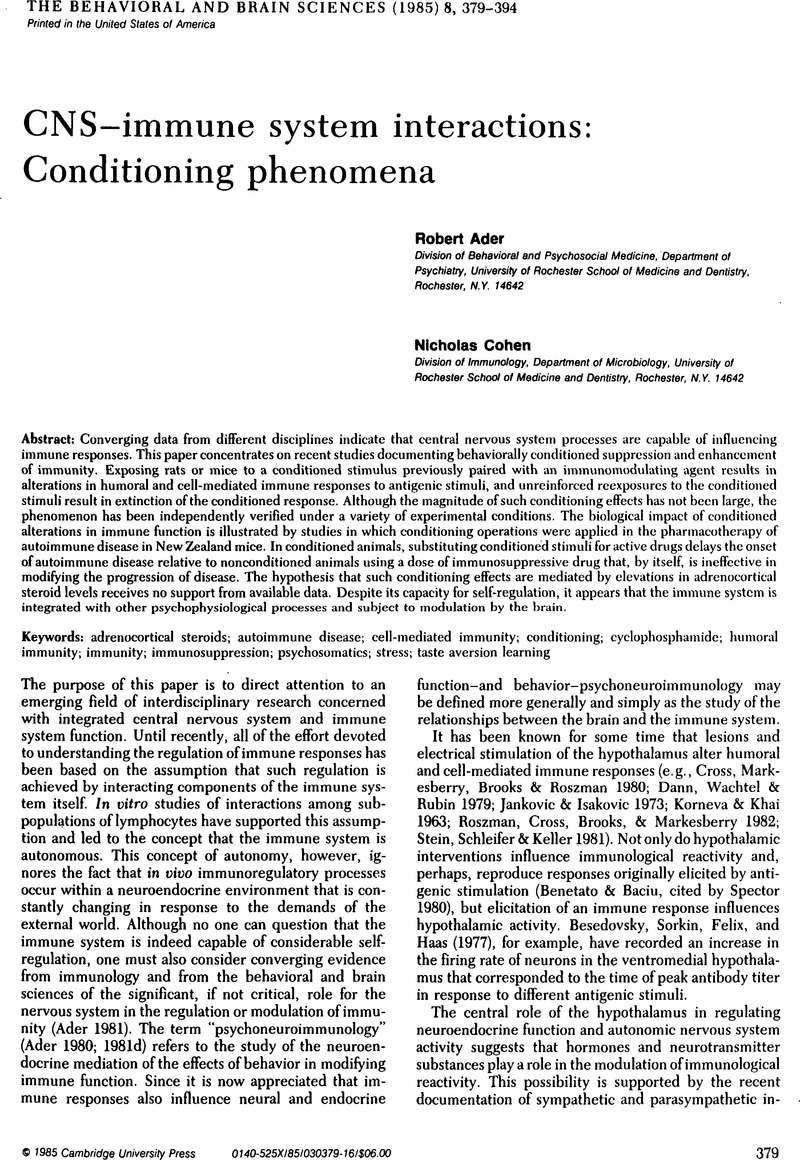Crossref Citations
This article has been cited by the following publications. This list is generated based on data provided by Crossref.
Jacobs, W. J.
1989.
What is classical conditioning?.
Behavioral and Brain Sciences,
Vol. 12,
Issue. 1,
p.
146.
Kehoe, E. James
1989.
Associative theory versus classical conditioning: Their proper relationship.
Behavioral and Brain Sciences,
Vol. 12,
Issue. 1,
p.
147.
Hollis, Karen L.
1989.
Preparatory response hypotheses: A muddle of causal and functional analyses.
Behavioral and Brain Sciences,
Vol. 12,
Issue. 1,
p.
145.
Riley, Anthony L.
1989.
Classical conditioning: A parsimonious analysis?.
Behavioral and Brain Sciences,
Vol. 12,
Issue. 1,
p.
157.
Lloyd, Dan
1989.
Extending the “new hegemony” of classical conditioning.
Behavioral and Brain Sciences,
Vol. 12,
Issue. 1,
p.
152.
Miller, Ralph R.
1989.
Classical conditioning: The new hyperbole.
Behavioral and Brain Sciences,
Vol. 12,
Issue. 1,
p.
155.
Alexieva, A.
and
Nicolov, N. A.
1989.
Brain mechanisms in classical conditioning.
Behavioral and Brain Sciences,
Vol. 12,
Issue. 1,
p.
137.
Samar, Vincent J.
and
Berent, Gerald P.
1989.
Classical conditioning and language: The old hegemony.
Behavioral and Brain Sciences,
Vol. 12,
Issue. 1,
p.
158.
Turkkan, Jaylan Sheila
1989.
Classical conditioning: The new hegemony.
Behavioral and Brain Sciences,
Vol. 12,
Issue. 1,
p.
121.
Kentridge, R. W.
1989.
Complexity at the organismic and neuronal levels.
Behavioral and Brain Sciences,
Vol. 12,
Issue. 1,
p.
147.
Klosterhalfen, Sibylle
and
Klosterhalfen, Wolfgang
1989.
Beyond respondent conditioning.
Behavioral and Brain Sciences,
Vol. 12,
Issue. 1,
p.
149.
Grossberg, Stephen
1989.
Classical conditioning: The role of interdisciplinary theory.
Behavioral and Brain Sciences,
Vol. 12,
Issue. 1,
p.
144.
Westland, James Christopher
and
Kochen, Manfred
1989.
Classical conditioning: A manifestation of Bayesian neural learning.
Behavioral and Brain Sciences,
Vol. 12,
Issue. 1,
p.
160.
Overmier, J. Bruce
1989.
Mis(sed)-representations.
Behavioral and Brain Sciences,
Vol. 12,
Issue. 1,
p.
156.
Domjan, Michael
and
Nash, Susan
1989.
Conditioning of sexual and reproductive behavior: Extending the hegemony to the propagation of species.
Behavioral and Brain Sciences,
Vol. 12,
Issue. 1,
p.
138.
Turkkan, Jaylan Sheila
1989.
Classical conditioning beyond the reflex: An uneasy rebirth.
Behavioral and Brain Sciences,
Vol. 12,
Issue. 1,
p.
161.
Locurto, Charles
1989.
The dark side of hegemony.
Behavioral and Brain Sciences,
Vol. 12,
Issue. 1,
p.
153.
Kimmel, H. D.
1989.
The importance of classical conditioning.
Behavioral and Brain Sciences,
Vol. 12,
Issue. 1,
p.
148.
Krank, Marvin D.
1989.
Pavlovian conditioning: Providing a bridge between cognition and biology.
Behavioral and Brain Sciences,
Vol. 12,
Issue. 1,
p.
151.
MacQueen, Glenda
MacRae, James
and
Siegel, Shepard
1989.
Contiguity, contingency, adaptiveness, and controls.
Behavioral and Brain Sciences,
Vol. 12,
Issue. 1,
p.
154.



